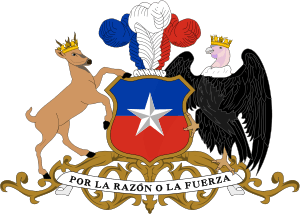Regions of Chile
| Regions of Chile Regiones de Chile (Spanish) | |
|---|---|
 | |
| Category | Unitary State |
| Location | Republic of Chile |
| Number | 15 |
| Populations | 98,413 (Aysén) – 6,683,852 (Metropolitan Santiago) |
| Areas | 80 km2 (31 sq mi) (Metropolitan Santiago) – 132,291 km2 (51,077.9 sq mi) (Magallanes and Chilean Antarctica) |
| Government | Limited autonomous government |
| Subdivisions | Province |
 |
| This article is part of a series on the politics and government of Chile |
| Comptroller General |
| Constitutional Court |
| Foreign relations |
Chile is divided into 15 regions (in Spanish, regiones; singular región), which are the country's first-level administrative division. Each region is headed by an intendant (intendente), appointed by the President, and an indirectly elected body known as regional board (consejo regional).
Regions are divided into provinces (second-level administrative division), each headed by a governor (gobernador), appointed by the President. There are 54 provinces, in total. Provinces are further divided into communes (third and lowest level administrative division), which are governed by municipalities.
Naming
Each region is given a Roman numeral, followed by a name (e.g. IV Región de Coquimbo, read as "fourth region of Coquimbo" in Spanish). When the regional structure was created, Roman numerals were assigned in ascending order from north to south, with the northernmost region designated as I (first) and the southernmost region as XII (twelfth). The Santiago Metropolitan Region, located in the center of the country and home to the country's capital Santiago, was excluded from this naming scheme and given instead the initials RM, standing for Región Metropolitana ("Metropolitan Region" in Spanish). With the creation of regions XIV in the south and XV in the north (XIII is not used) in 2007, the north-south Roman numeral order was broken.
History of the regional structure
The administrative divisions of Chile were created in 1974 and limited to 13 regions (this limitation was eliminated in 2005 via a constitutional reform). Previously, Chile was divided into 25 provinces, which were further divided into departments, and then into communes. The new territorial organization was implemented in phases with some initial "pilot regions" beginning to operate in 1974, extending the process on January 1, 1976 to the rest of the country. The Santiago Metropolitan Region began to operate in April 1980.
In December 2006, two new regions were created: the northern Arica and Parinacota Region, by taking out the two northernmost provinces from the Tarapacá Region; and Los Ríos Region in the south, encompassing the provinces of Valdivia, formerly part of the Los Lagos Region, and Ranco, formerly part of Valdivia.[1] Both regions became operative in October 2007.
List of regions
| Key[2][3] | Flag | Name (English/Spanish) |
Capital | Area (km2) | Population (2015) |
Order from north to south |
|---|---|---|---|---|---|---|
| 01 | Tarapacá Región de Tarapacá |
Iquique | 42,225.8 | 336,769 | 2 | |
| 02 | Antofagasta Región de Antofagasta |
Antofagasta | 126,049.1 | 622,640 | 3 | |
| 03 | Atacama Región de Atacama |
Copiapó | 75,176.2 | 312,486 | 4 | |
| 04 | Coquimbo Región de Coquimbo |
La Serena | 40,579.9 | 771,085 | 5 | |
| 05 | Valparaíso Región de Valparaíso |
Valparaíso | 16,396.1 | 1,825,757 | 6 | |
| 06 | O'Higgins Región del Libertador General Bernardo O'Higgins |
Rancagua | 16,387 | 918,751 | 8 | |
| 07 | Maule Región del Maule |
Talca | 30,296.1 | 1,042,989 | 9 | |
| 08 | Bío Bío Región del Bío Bío |
Concepción | 37,068.7 | 2,114,286 | 10 | |
| 09 | Araucanía Región de La Araucanía |
Temuco | 31,842.3 | 989,798 | 11 | |
| 10 | Los Lagos Región de Los Lagos |
Puerto Montt | 48,583.6 | 841,123 | 13 | |
| 11 | Aisén Región Aisén del General Carlos Ibáñez del Campo |
Coihaique | 108,494.4 | 108,328 | 14 | |
| 12 | Magallanes Región de Magallanes y de la Antártica Chilena |
Punta Arenas | 132,291.1 | 164,661 | 15 | |
| 14 | Los Ríos Región de Los Ríos |
Valdivia | 18,429.5 | 404,432 | 12 | |
| 15 | Arica and Parinacota Región de Arica y Parinacota |
Arica | 16,873.3 | 239,126 | 1 | |
| 16 | Santiago Región Metropolitana de Santiago |
Santiago | 15,403.2 | 7,314,176 | 7 |
See also
References
- ↑ La Nación
- ↑ "Regiones, Provincias y Comunas de Chile". Subsecretaria de Desarrollo Regional y Administrativo. Retrieved 19 November 2015.
- ↑ "CODIGO UNICO TERRITORIAL" (PDF). Subsecretaria de Desarrollo Regional y Administrativo. Retrieved 19 November 2015.